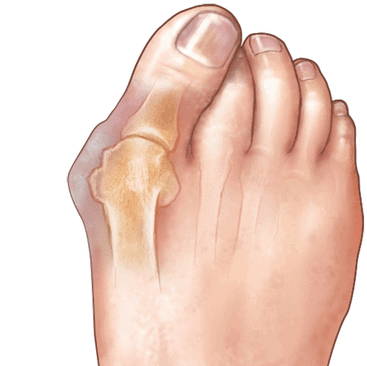The foot consists of 26 bones, more than 30 joints and a large number of ligaments, nerves and blood vessels. The loads that the feet suffer during normal walking are two to three times greater than the body weight, and when running even four to ten times. Scientists claim that no artificial structure could withstand such a great effort. If the foot, in addition to moving and carrying a higher body weight, is exposed to inappropriate footwear, which restricts the nature of movements, it will react with blisters, pain and various deformities.
The formation of bunions
Dr. Branislav Krivokapić: ” The reason for the formation of bunions is most likely poorly fitted shoes. In Japan, several centuries ago, when they used only slippers or walked barefoot, a very small number of the population (maybe not even anyone) had problems with foot deformities or bunions. The current modern world and modern footwear, especially high heels, transfer a great support to the front part of the foot, and thus the deformity of the bunion is more common. ”

Bunions are much more common in women, but men are not spared either. Bunions mainly occur on both feet. The cause can also be of a genetic nature, but it has not been proven what exactly influences on their creation. Bunions are not only a disease of the elderly population, but also young people suffer from them.
Dr. Branislav Krivokapić: ” Bunions also appear in the earliest childhood or adolescence, most often in girls. Bunions initially represent only an aesthetic deformity. However, they start to hurt very quickly. We still don’t have preventive measures and we can’t say for sure that something would help. In the past, so-called separators between the first and second toe were widely used. However, over time, it has become clear that separators do not have much efficiency. The operation is best done as early as possible, because there is a movement of other toes and thus much larger deformities of the whole foot, which require much larger and more difficult surgery and more difficult recovery. ”
It is important to go to the doctor as soon as possible, as soon as you notice an aesthetic change in your feet.
Dr. Branislav Krivokapić: “ Clinical examination is very important. However, it is obligatory to make an X ray of the feet in two directions, preferably while standing. Based on the image, we measure certain angles. In that way, we present to the patient what and how much could be corrected and what the patient can expect after the operation. As for the bunions themselves, there are about 300 techniques described. When something like that exists then you know that no technique is perfect. Some methods are soft tissue methods, which mean that they work only on the soft tissues, ligaments and tendons in the foot itself. The largest number belongs to so called bone methods and various osteotomies, depending on the degree of deformity. It is an operation that is often performed everywhere in the world, even here in our country. ”

As Dr. Krivokapić said, there is no perfect technique. In some patients, the deformity will never return, but in some it reoccurs. The patient who had the operation is 30 years old and has bunion on only one foot, which is very rare.
Dr. Branislav Krivokapić: “ With this patient, we decided to perform a Chevron osteotomy of the first metatarsal bone-the joint of the first metatarsal bone. It is the ankle of the big toe that we moved inwards to return the big toe to the shaft. Of course, we loosened the tendons that pull the finger out so that it stays in that position after the operation. ”

Recovery after surgery
Dr. Branislav Krivokapić: “It should take six to eight weeks for complete recovery. This is the time for the osteotomy to heal. Osteotomy is a violent bone fracture that we perform to achieve a result. The patient will walk without support for the next two weeks, and after that she can walk with support on her heel. In order for the patient to start relying on the whole foot, it takes six to eight weeks for the osteotomy to heal and for the patient to return to a normal life. ”
You can view the entire article by clicking HERE.
